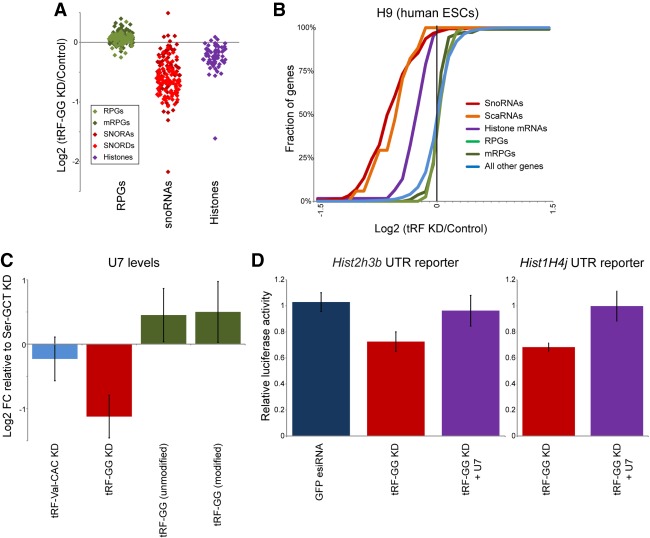Figure 3.
tRF-Gly-GCC supports production of U7 and other noncoding RNAs. (A) Effects of tRF-GG inhibition on several gene families in human H9 ES cells. Individual dots show individual members of the indicated families, illustrating the widespread down-regulation of histone and snoRNA genes in response to tRF-GG inhibition. Ribosomal protein genes are shown as a representative highly expressed, but tRF-insensitive, gene family for comparison. Effects on several snoRNAs are independently validated by qRT-PCR and Northern blot in Supplemental Figure S5A,D,E. (B) Cumulative distribution plots showing tRF effects on the indicated gene families, as in Figure 2C. (C) Manipulating tRF-GG levels affects U7 snRNA production. ES cells were transfected either with LNA antisense oligos targeting tRF-Ser-GCT, tRF-Val-CAC, or tRF-GG, or with synthetic tRF-GG oligos either bearing appropriate modified nucleotides (modified) or lacking these modifications (unmodified). U7 levels were quantitated by Northern blot (n = 4) and normalized relative to 5S rRNA levels. Change in U7 levels is expressed relative to tRF-Ser-GCT inhibition (as an unrelated LNA control), revealing a significant (P = 0.03) decrease in U7 levels in response to tRF-GG inhibition, as well as modestly increased U7 levels in tRF-GG-supplemented cells. See also Supplemental Figure S5B,C,E. (D) Effects of tRF-GG KD on histone 3′ UTR reporters are suppressed by supplementation with additional U7 snRNA. ES cells were transfected with the LNA antisense to tRF-GG, with or without additional in vitro-synthesized U7 RNA. Effects of tRF-GG KD were significant (P = 0.0039 and 0.00013 for H3 and H4 reporters, respectively), while tRF-GG KD + U7 was statistically indistinguishable from control (P = 0.24 and 0.48, respectively). See also Supplemental Figure S6.

